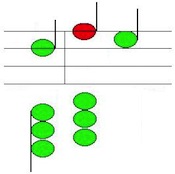
HARMONIC EXPANSIONS
CHAPTER 2: NONHARMONIC TONES
2.13 Appoggiaturas
 |
 |
 |
In the above excerpt from the first movement of Mozart's Eine Kleine Nachtmusik the first violin's A (in red) at the beginning of measure 7 is approached by skip from an F-sharp and then resolves down by step to G, the root of the accompanying I chord. The A is nonharmonic with respect to this G chord and is called an appoggiatura (APP). In this excerpt the appogiatura serves to accent the first beat of the measure in a way similar to the trilled suspensions at the beginning of measures 6 and 8. (Measures 6 and 8 have a dominant-seventh harmony (D7) against a pedal tone G in the cellos and basses.)
|
In general, appoggiaturas are approached by a leap up and then resolve down by step. See the graphic to the right. Appoggiaturas are accented nonharmonic tones; they are sounded at the start of the accompanying harmony, not afterwards. Occasionally a nonharmonic tone is approached by a leap downward and resolves upward by step. This is called an inverted appoggiatura, from the term, "melodic inversion." |

|
|
In four voices In the video on the left an appoggiatura expands the final tonic. |
|
|
In the following excerpt from the second movement of Beethoven's Sonata Op.2 No.1, the high F in the next-to-the-last measure is decorated by an appoggiatura and neighbor tone. | |
|
An inverted appoggiatura appears in "Kije's Wedding," the third movement of Prokofiev's Lieutenant Kije. In measure 2 below, the cornet leaps down to an A-natural--a non-chord with respect to the accompanying E-flat major triad (see the chord in the horns) and a very dissonant tritone against the tuba's E-flat. The A-natural then resolves in the opposite direction by step to the chord tone B-flat. | |
 |
 |
 |
 |
Comments? Click here. |



